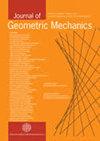Control of locomotion systems and dynamics in relative periodic orbits
IF 1
4区 数学
Q3 MATHEMATICS, APPLIED
引用次数: 6
Abstract
The connection between the dynamics in relative periodic orbits of vector fields with noncompact symmetry groups and periodic control for the class of control systems on Lie groups known as '(robotic) locomotion systems' is well known, and has led to the identification of (geometric) phases. We take an approach which is complementary to the existing ones, advocating the relevance——for trajectory generation in these control systems——of the qualitative properties of the dynamics in relative periodic orbits. There are two particularly important features. One is that motions in relative periodic orbits of noncompact groups can only be of two types: either they are quasi-periodic, or they leave any compact set as \begin{document}$ t\to\pm\infty $\end{document} ('drifting motions'). Moreover, in a given group, one of the two behaviours may be predominant. The second is that motions in a relative periodic orbit exhibit 'spiralling', 'meandering' behaviours, which are routinely detected in numerical integrations. Since a quantitative description of meandering behaviours for drifting motions appears to be missing, we provide it here for a class of Lie groups that includes those of interest in locomotion (semidirect products of a compact group and a normal vector space). We illustrate these ideas on some examples (a kinematic car robot, a planar swimmer).相对周期轨道上的运动系统和动力学控制
The connection between the dynamics in relative periodic orbits of vector fields with noncompact symmetry groups and periodic control for the class of control systems on Lie groups known as '(robotic) locomotion systems' is well known, and has led to the identification of (geometric) phases. We take an approach which is complementary to the existing ones, advocating the relevance——for trajectory generation in these control systems——of the qualitative properties of the dynamics in relative periodic orbits. There are two particularly important features. One is that motions in relative periodic orbits of noncompact groups can only be of two types: either they are quasi-periodic, or they leave any compact set as \begin{document}$ t\to\pm\infty $\end{document} ('drifting motions'). Moreover, in a given group, one of the two behaviours may be predominant. The second is that motions in a relative periodic orbit exhibit 'spiralling', 'meandering' behaviours, which are routinely detected in numerical integrations. Since a quantitative description of meandering behaviours for drifting motions appears to be missing, we provide it here for a class of Lie groups that includes those of interest in locomotion (semidirect products of a compact group and a normal vector space). We illustrate these ideas on some examples (a kinematic car robot, a planar swimmer).
本文章由计算机程序翻译,如有差异,请以英文原文为准。
求助全文
约1分钟内获得全文
求助全文
来源期刊

Journal of Geometric Mechanics
MATHEMATICS, APPLIED-PHYSICS, MATHEMATICAL
CiteScore
1.70
自引率
12.50%
发文量
23
审稿时长
>12 weeks
期刊介绍:
The Journal of Geometric Mechanics (JGM) aims to publish research articles devoted to geometric methods (in a broad sense) in mechanics and control theory, and intends to facilitate interaction between theory and applications. Advances in the following topics are welcomed by the journal:
1. Lagrangian and Hamiltonian mechanics
2. Symplectic and Poisson geometry and their applications to mechanics
3. Geometric and optimal control theory
4. Geometric and variational integration
5. Geometry of stochastic systems
6. Geometric methods in dynamical systems
7. Continuum mechanics
8. Classical field theory
9. Fluid mechanics
10. Infinite-dimensional dynamical systems
11. Quantum mechanics and quantum information theory
12. Applications in physics, technology, engineering and the biological sciences.
 求助内容:
求助内容: 应助结果提醒方式:
应助结果提醒方式:


